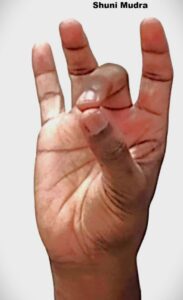Shuni Mudra
Introduction
Mudras are symbolic hand gestures in yoga that influence prana (life energy), affecting physical, mental, and spiritual well-being. Shuni Mudra, also called the “seal of patience” or “Saturn Mudra”, is a mudra that enhances discipline, patience, focus, and stability.
The term “Shuni” in Sanskrit refers to Saturn, symbolizing patience, endurance, and discernment. This mudra is commonly used to cultivate patience, mental clarity, and spiritual discernment, often in meditation and pranayama practices.

Meaning
- Shuni = Saturn, patience, endurance, stability.
- Mudra = Yogic seal or gesture.
Purpose: To develop patience, mental stability, wisdom, and spiritual awareness, while regulating prana in the body.
How to Perform (Practice)
- Sit comfortably in Sukhasana, Padmasana, or Vajrasana, keeping the spine erect.
- Relax shoulders and arms.
- The middle finger and thumb are lightly touching the tips.
- Use enough pressure to feel the flow of energy but not to whiten the fingers.
- The remaining three fingers are gently pulled out, relaxed but not ridiculed.
- Close your eyes, breathe slowly, and focus on cultivating patience, discipline, and inner balance.
- Maintain the mudra for 10–15 minutes, gradually increasing with regular practice.
Tip: Keep the gesture gentle; avoid tension in fingers or shoulders.
Benefits
Physical Benefits
- Improves circulation and pranic flow in the fingers and hands.
- Supports nervous system balance.
- Helps in reducing fatigue and improving overall energy levels.
Mental & Emotional Benefits
- Enhances patience, focus, and mental clarity.
- Reduces impulsiveness, stress, and agitation.
- Improves decision-making and emotional stability.
Spiritual Benefits
- Activates prana and energy flow in subtle channels.
- Enhances discernment, wisdom, and inner awareness.
- Supports meditation and mental discipline, cultivating higher consciousness.
Contraindications
- Finger, hand, or thumb injuries.
- Avoid over-practice if fingers or hands feel fatigued.
- Not recommended for severe joint or arthritis issues without guidance.
Anatomy & Physiology
- Musculoskeletal: Engages intrinsic hand muscles, stabilizes fingers, and lightly activates forearm muscles.
- Circulatory system: Enhances blood flow in hands and fingers.
- Nervous system: Stimulates sensory nerve endings, enhancing focus and attention.
- Endocrine system: Supports subtle energy regulation linked to mental clarity and balance.
Kinesiology
- Middle finger touches thumb to form a circle, other fingers extended.
- Hands rest on thighs or knees, wrists neutral.
- Shoulders relaxed, elbows slightly bent.
- Promotes stability, hand proprioception, and subtle energy direction.
Neurology
- Stimulates peripheral nerves of the fingers, enhancing attention and sensory awareness.
- Promotes parasympathetic activity, reducing stress and mental agitation.
- Activates cortical areas related to focus, patience, and cognitive control.
- Supports energy flow and meditative awareness.
Duration of Mudra
- Beginners: 5–10 minutes.
- Intermediate: 10–15 minutes.
- Advanced: 20–30 minutes during meditation or pranayama.
Tip: Daily practice improves mental patience, emotional balance, and focus.
Counter Mudra
- Gyan Mudra: To enhance knowledge and memory after patience-focused practice.
- Prana Mudra: To energize body after Shuni Mudra.
- Shaant Mudra: To calm excessive mental activity.
Conclusion
Shuni Mudra is a hand gesture that cultivates patience, mental stability, focus, and inner wisdom. Regular practice supports emotional balance, mental clarity, and pranic flow, making it ideal for meditation, mindfulness, and spiritual practices.
FAQ
Q1. Can beginners practice Shuni Mudra?
Yes, it is simple and safe for all levels.
Q2. Can it help with impatience or stress?
Yes, it enhances patience, emotional stability, and focus.
Q3. How long should it be practiced daily?
5–10 minutes for beginners; up to 30 minutes for advanced practitioners.
Q4. Can it be combined with meditation or pranayama?
Yes, it is particularly effective in meditation and mindfulness practices.
References
- Swami Satyananda Saraswati, Asana, Pranayama, Mudra, Bandha.
- B.K.S. Iyengar, Light on Yoga.
- Hatha Yoga Pradipika – Mudras for mental discipline and pranic regulation.
- Gheranda Samhita – Mudras for patience, focus, and meditation.
- Kuvalayananda, Yoga Mimamsa Journal.
